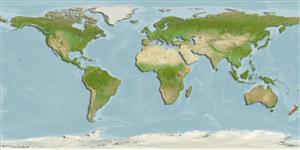Classification / Names
ชื่อสามัญ | ชื่อพ้อง | Catalog of Fishes(สกุล, ชนิด) | ITIS | CoL | WoRMS | Cloffa
>
Pleuronectiformes (Flatfishes) >
Rhombosoleidae (South Pacific flounders)
Etymology: Peltorhamphus: Greek, pelteos, peltes = a fish named as "korakinos"; when it was salted received the name of "pelte" + Greek, rhamphos = bill (Ref. 45335).
Environment: milieu / climate zone / depth range / distribution range
นิเวศวิทยา
เกี่ยวกับทะเล,น้ำเค็ม สัตว์น้ำหน้าดิน; ระดับความลึก 5 - 47 m (Ref. 123823), usually 9 - 38 m (Ref. 123823). Subtropical
Southwest Pacific: New Zealand.
ขนาด / น้ำหนัก / Age
Maturity: Lm ? range ? - ? cm
Max length : 15.7 cm SL เพศผู้/กระเทย; (Ref. 123823); 16.1 cm SL (female)
Short description
สัณฐานวิทยา | ความยาวต่างๆ
ก้านครีบอ่อนที่หาง (รวม): 98-116; ก้านครีบอ่อนที่ก้น: 62 - 72. This species is distinguished from its congeners by the following set of characters: elongated body with greatest depth more evenly distributed over its length and with more gradual posterior taper beyond this point; long, filamentous second ocular-side pectoral-fin ray is longer than, or equal to its greatest body depth; head relatively narrow; scales on blind sides of dorsal- and anal-fin rays (at sizes ? 70 mm SL); with higher and mostly non-overlapping meristic values, total vertebrae ? 40, D 98-116, A 62-72, lateral-line pores 82-106,supracranial pterygiophores 25-31, usually 10–15 ; gill rakers on first gill arch usually 10-5; scales between mid-eye and dorsal margin of head usually 8-10; scales between anteroventral margin of lower (non-migrated) eye and dorsal margin of rostral hood above mouth usually 4-6; relatively small, thin gill rakers on upper limb of first gill arch. not reaching dorsalmost gill rakers on lower limb; with 1-5 fleshy, finger-like filaments on inner anteroventral margin of fleshy skinfold on ocular-side lower jaw; IO space relatively wide; and morphometric features including shorter postorbital length, narrower upper and lower head lobes, narrower caudal peduncle, smaller ratio of HW/HL, longer snout, and smaller eye. Colouration: ocular side with several faint longitudinal lines and sometimes with up to three dark blotches along lateral line; dorsal- and anal-fin rays and roof of mouth are uniformly pigmented; inner lining of ocular-side opercle dusky (not black) (Ref. 123823).
Found in subtidal coastal waters on sandy or sandy-mud bottoms. Small juveniles are caught at depths similar to those of adults, but juveniles are known to inhabit shallow water, not shallow-water inlets, perhaps reflecting an avoidance for areas with soft, silty substrates. Prey consumed may be similar to is congeners based on jaw morphology and mouth size, thus feeding on small small epibenthic and infaunal invertebrates such as crustaceans, molluscs, and polychaetes (Ref. 123823).
Life cycle and mating behavior
วัยเจริญพันธุ์ | การสืบพันธุ์ | การวางไข่ | เซลสืบพันธ์ของเพศเมีย(ไข่) | ความดกของไข่ | ตัวอ่อน
Munroe, T.A., 2021. Systematic revision of the flatfish genus Peltorhamphus Günther, 1862 (Teleostei: Pleuronectiformes: Rhombosoleidae), including description of a new species from Southeastern New Zealand, with biological and ecological summaries for the species. Zootaxa 4905(1):1-104. (Ref. 123823)
IUCN Red List Status (Ref. 130435)
Threat to humans
Harmless
Human uses
ข้อมูลเพิ่มเติม
ชื่อสามัญชื่อพ้องกลไกการเผาผลาญพลังงานผู้ล่าการศึกษาเกี่ยวกับผลกระทบของสารประกอบทางเคมีที่เป็นอันตรายต่อสิ่งมีชีวิต ประชากร และสิ่งแวดล้อมการสืบพันธุ์วัยเจริญพันธุ์การวางไข่การรวมกลุ่มวางไข่ความดกของไข่เซลสืบพันธ์ของเพศเมีย(ไข่)Egg development
Age/SizeการเจริญเติบโตLength-weightLength-lengthLength-frequenciesความยาวต่างๆสัณฐานวิทยาตัวอ่อนพลวัตของสัตว์น้ำวัยอ่อนการทดแทนที่อุดมสมบรูณ์BRUVS
อ้างอิงการเพาะเลี้ยงสัตว์น้ำประวัติการเพาะเลี้ยงสัตว์น้ำสายพันธุ์พันธุศาสตร์ElectrophoresesอัตราพันธุกรรมโรคการแปรรูปNutrientsMass conversion
ผู้ร่วมมือรูปภาพหลายรูปStamps, Coins Misc.เสียงปลามีพิษ เช่น ปลาปักเป้าความเร็วรูปแบบการว่ายน้ำพื้นที่เหงือกOtolithsสมองวิสัยทัศน์
เครื่องมือ
Special reports
Download XML
แหล่งที่มาจากอินเตอร์เน็ต
Estimates based on models
Preferred temperature (Ref.
123201): 10.6 - 18.2, mean 14.9 °C (based on 146 cells).
Phylogenetic diversity index (Ref.
82804): PD
50 = 0.6250 [Uniqueness, from 0.5 = low to 2.0 = high].
Bayesian length-weight: a=0.01820 (0.00786 - 0.04213), b=2.97 (2.76 - 3.18), in cm total length, based on LWR estimates for this (Sub)family-body shape (Ref.
93245).
ระดับชั้นอาหาร (Ref.
69278): 3.1 ±0.2 se; based on size and trophs of closest relatives
ความสามารถในการกลับคืนสู่ปกติ (Ref.
120179): ความสูง, เวลาต่ำสุดที่จะทำให้ประชากรเพิ่มขึ้นเป็น 2 เท่าใช้เวลาน้อยกว่า 15 เดือน (Preliminary K or Fecundity.).
Fishing Vulnerability (Ref.
59153): Low vulnerability (10 of 100).
